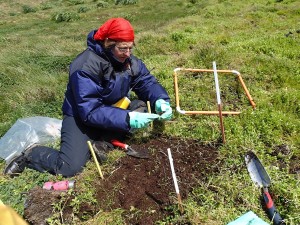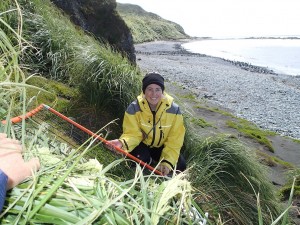Invasive species are a major contributor to loss of biodiversity worldwide and introduced plants can pose a significant threat to the ecosystems they invade. Unfortunately despite their remote location, Subantarctic Islands still harbour exotic vascular plant species ranging in number from 1 (Heard Island) to 69 species (Kerguelen Archipelago). Macquarie Island, some 1500 km south of Hobart in the Great Southern Ocean and a World Heritage Area under the control of the Tasmanian Government, has three exotic plant species: Cerastium fontanum (mouse eared chickweed) and Stellaria media (chickweed) both in the Caryophyllaceae family; and Poa annua (winter grass) in the Poaceae family. All three species are amongst the most widespread exotic species on Subantarctic Islands.
Following the successful invasive mammal eradication project on Macquarie Island in 2013 it is also important to look at the potential impact that exotic vascular plant species may be having on Macquarie Island ecosystems. Stellaria media is a highly palatable plant that has been accidentally introduced to most Subantarctic Islands. On Macquarie Island it was first recorded at Lusitania Bay in 1884. Since the first observation S. media has almost entirely been recorded in the northern third of the island. Prior to the rabbit eradication on Macquarie Island, S. media was probably suppressed by grazing rabbits. Now, with the removal of rabbits there is the potential that S. media may flourish with the absence of grazing pressure. Anecdotal evidence already points towards a much larger growth form than was observed before rabbits were removed. Alternatively as the plant is thought to favour disturbed locations, S. media may be suppressed once again by the recovering native vegetation as it also experiences a comeback following the removal of invasive mammals.
Currently little is known about the ecology of S. media in the Subantarctics. This summer is the first of a three year PhD project funded by the Australian Antarctic Division and the University of New England (UNE) to understand the population ecology and potential for control of S. media in a post rabbit environment on Macquarie Island. My field assistant and fellow botanist Karen Ziegler and I are focusing on several facets of my PhD research in this first field season. Firstly we are surveying known sites of S. media infestation to understand the size, density, and population structure of S. media and its native plant associations across Macquarie Island. Secondly we are collecting soil samples in order to see if S. media has a seed bank that would allow reinvasion of a site if above ground material was removed. Thirdly, we are setting up a management trial to see how effective hand weeding of S. media would be on Macquarie Island. Lastly we are looking in aspects of the biology of S. media, such as; biomass allocation, flowering phenology, seed production and dispersal in order to better understand the reasons for the success of this weed in this environment and to compare its biology with S. media from other places around Australia and New Zealand.
Back in Australia at UNE over the winter, I will set up a series of germination trials to understand the germination requirements of S. media in a Subantarctic system. I will also grow some plants for a herbicide trial in order to understand how effective herbicides would be at removing S. media in a cold climate.
This is the first visit to Macquarie Island for Karen and me and we’re both constantly amazed by the flora, fauna (penguins!), and the ever changing weather. This truly is a special island and we feel so privileged to be here.
Jane’s PhD supervisors are Prof Brian Sindel, A/Prof Paul Kristiansen and Dr Sue Wilson, all from the School of Environmental and Rural Science at UNE, as well as Dr Justine Shaw from the Australian Antarctic Division. This project follows on from another, highly successful, research project recently conducted by UNE PhD student Laura Williams on one of the two other weeds on Macquarie Island, Poa annua or winter grass. http://www.une.edu.au/about-une/academic-schools/school-of-environmental-and-rural-science/research/research-themes/plant-soil-and-environment-systems/weed-science/sub-antarctic-ecology-and-management


